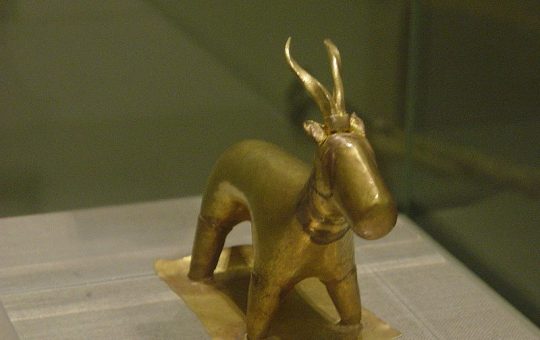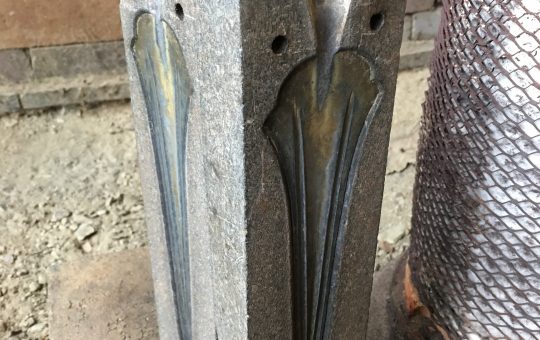How Were Bronze-Age Swords Used?

At Molten Bronze, you can make a sword based on one found in Dublin, Ireland, from over 3,000 years ago. Humans have clearly been making swords for a very long time, and a lot of effort, care and attention went into every one created – but how exactly were these ancient weapons used?
The leaf-shaped swords made at Molten Bronze are replicas of a style that was very common in Britain, Ireland and other Celtic countries throughout the Bronze Age. In the constant, ever-evolving arms race of weapons technology, this blade was the pinnacle for hundreds of years, and the advantages over other sword designs made it the ideal weapon for champions, chieftains and soldiers alike.
The First Bronze-Age Swords
The first Bronze Age swords evolved naturally from daggers – dual-edged blades designed purely for stabbing. As the picture shows, they came quickly to a point, and couldn’t have been used well for slicing or chopping action. Jabbed into a gap in armour or used in very close quarters, where its short length would have given it an advantage over spears, axes or bludgeons, these swords would still have been deadly in combat.
Leaf-Shaped Blades
Leaf-shaped blades were a common type of Bronze Age sword in the mid-to-late Bronze Age in Europe – particularly in Britain and Ireland. They could also be found in continental Europe, and enjoyed some fame in Greece as the xiphos, a short sword associated with Greek heroes and hoplite warfare.
It was so successful thanks to its incredible effectiveness, and it was versatile enough to have a significant edge over other sword types of the day, which, like the stabbing swords described above, were more likely to be specific, single-function tools.
The leaf-shaped blades made at Molten Bronze would have been used predominantly as slicing weapons, with their gently curved edges creating ideal conditions for deep, easy draw cuts. A demonstration on a leg of lamb once the swords were finished left none of my group under any illusions as to the effectiveness of the cutting action – these swords are very efficient slicing machines.
They can also be used in thrusting, and the dual-edged, dagger-like point of the blade helps facilitate this. The rise of the sword brought with it a new era of warfare: one in which those who could afford the precious bronze sword were able to kill more easily than ever before. No longer were the weapons of common men and professional warriors on an equal footing – now, the richer soldiers and chieftains had an incredible advantage.

Using Bronze Swords in Single Combat – Battle Between Champions
One of the interesting things about Bronze Age warfare across the globe is the occurrence of duels between champions. Noted in the Iliad, in Ancient Roman history, in the Indian Mahabharata and the Irish Ulster Cycle, combat between single exalted warriors was seemingly commonplace in the ancient world. Even the story of David and Goliath is a classic tale of Bronze-Age champion warfare.
Usually carried out between the two opposing armies, the champions’ duel may decide the outcome of the battle itself, or may simply be an opening salvo of violence, depriving the enemy of a great warrior and scoring a morale victory before the armies clashed.
In these circumstances, the leaf-shaped bronze swords, like those you’ll make at Molten Bronze, would have been vital weapons. With greater reach and weight than a dagger or knife and much more versatility than a spear, axe or club, these multifunctional weapons would have given a duellist the best possible chance to successfully kill the enemy, survive the fight… and maybe even avert a larger conflict altogether.
Using Bronze Swords in Massed Combat
Massed battles in the Bronze Age most likely weren’t the huge, chaotic slaughters shown by Hollywood – most likely, battles between massed soldiers would have been a few hundred men at most, since most disputes would have been at the tribal or community level.
The leaf-shaped blade would have been a useful and efficient weapon even in tightly-packed ranks, however, with enough reach to strike the enemy without becoming cumbersome. Since it was a one-handed weapon, the wielder could still used a shield as well, maintaining their place as a member of a shield wall or simply defending themselves from arrows, sling-stones and enemy spears.
The double-edged sword could have been thrust through the opposition’s defence, or drawn across the vulnerable less-armoured parts of an enemy soldier to create deep slicing wounds. It is no accident that these swords bear such a striking resemblance to the swords of the famously tight-knit Bronze-Age Greek hoplites. The design was effective, and so it won out over other Bronze-Age weapons systems.
Sacrificing a Sword to the Gods
The sword that you’ll make at Molten Bronze is based off an Irish Chieftain’s sword from 3,000 years ago – but what you might not know is that that sword was found broken into three pieces, bound together, and thrown into a bog.
As immensely powerful and precious items, a lot of spirituality and mythology was bound up in swords. Sacrificing one to the gods represented a gift of incredible value – some historians estimate that a bronze sword had equivalent value in the Bronze Age as a house does today! If you were a chieftain and you needed the favour of the gods, there were few better offerings than a ritually-broken sword.
Ever Wanted to Make a Sword?
If you’ve ever wanted to make a sword, then the bronze casting workshops at Molten Bronze will be perfect for you. Run over two days on the weekend, these residential courses are a hands-on way to make a sword, and you’ll leave at the end of the weekend with your own piece of history to keep – a bronze sword worthy of the mightiest champion, the most grizzled hoplite or the most resplendent ancient king. So what are you waiting for? Come and make a sword with us!
Contact Molten Bronze Today!
If you’d like to make a sword at Molten Bronze, or if you’re interested in our lost wax bronze casting workshops, you can get in touch with Dave using the Contact Page of this site, or by email at dave@bronzeagefoundry.com
It’s a fantastic way to spend a weekend, even if you have no plans to face down an enemy tribe’s champion afterwards – so get in touch to make a booking and remake your own piece of ancient history!


